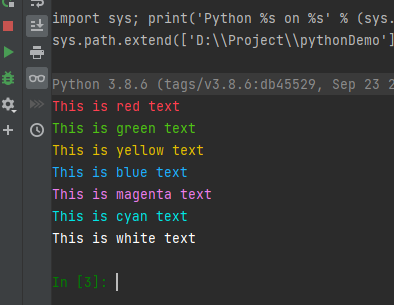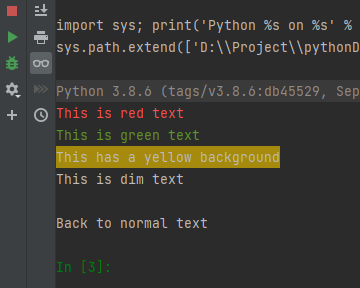方法一
示例代码:
1 2 3 4 5 6 7 8 9 10 11 12 13 14 15 16 17 | # ANSI escape codes for some colorsRED = '33[91m'GREEN = '33[92m'YELLOW = '33[93m'BLUE = '33[94m'MAGENTA = '33[95m'CYAN = '33[96m'WHITE = '33[97m'RESET = '33[0m' # Resets the color to defaultprint(f"{RED}This is red text{RESET}")print(f"{GREEN}This is green text{RESET}")print(f"{YELLOW}This is yellow text{RESET}")print(f"{BLUE}This is blue text{RESET}")print(f"{MAGENTA}This is magenta text{RESET}")print(f"{CYAN}This is cyan text{RESET}")print(f"{WHITE}This is white text{RESET}") |
效果:

方法二
需要termcolor的支持
1 | pip install colorama |
示例代码:
1 2 3 4 5 6 7 8 9 10 11 | from colorama import Fore, Back, Style, init# Initialize Coloramainit(autoreset=True)print(Fore.RED + 'This is red text')print(Fore.GREEN + 'This is green text')print(Back.YELLOW + 'This has a yellow background')print(Style.DIM + 'This is dim text')print(Style.RESET_ALL)print('Back to normal text') |
效果:

方法三
需要termcolor:
1 | pip install termcolor |
1 2 3 4 5 | from termcolor import coloredprint(colored('Hello, World!', 'red'))print(colored('Green text', 'green'))print(colored('Blue text', 'blue', 'on_white')) # Blue text on white background |
到此这篇关于python输出带有颜色文字的三种方法的文章就介绍到这了,更多相关python输出带颜色文字内容请搜索IT俱乐部以前的文章或继续浏览下面的相关文章希望大家以后多多支持IT俱乐部!

